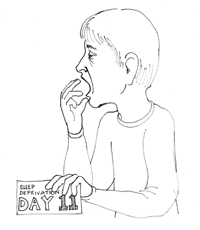STRANGEBUTTRUE- Sleep deprivation: It'll kill you before starvation

DRAWING BY DEBORAH DERR McCLINTOCK
Q. What was different about healthy 17-year-old San Diego schoolboy Randy Gardner when he awoke at 6am on December 28, 1963? –R. VanWinkle
A. He didn't go back to sleep again until the morning of January 8, 1964– that's 11 days without sleep! These 264 hours remain the longest scientifically verified period without sleep, breaking the previous record of 260 hours.
For the final three days, Stanford University's William Dement stayed awake with Gardner, who experienced mood swings, memory and attention lapses, loss of coordination, slurred speech, and hallucinations.
"Otherwise, he was just fine. His first sleep after the 11 days lasted just 14 hours," says Graham Lawton in New Scientist magazine.
Gardner took no stimulants during his "wakeathon," but did have people around to help him stay awake. Without this, sleep would have become nearly irrepressible within 48 hours. Sleep-deprived people slip in and out of subtle "microsleeps"– seconds of sleep that may go unnoticed, often with eyes open.
Microsleeps aside, how long could Gardner have continued? Nobody knows, but it is known that sleep deprivation is eventually fatal. Rats kept awake die after two weeks, less time than it takes them to starve to death.
There are no records of a human intentionally kept awake to that point, but the hereditary disease "fatal familial insomnia" suggests that an ultimate limit does exist. "The disease eventually robs victims of the ability to sleep, bringing on death within three months," Lawton writes.
Q. What's the weight of that fleecy cloud drifting across the sky? –W. Wordsworth
A. That's what meteorologist Margaret LeMone wondered as she set out to "weigh" a smallish cumulus cloud over the Plains east of Boulder, CO, says John A. Adam in A Mathematical Nature Walk. It helped that in many regions west of the Appalachians, U.S. highways mark the land into squares a mile by a mile. This particular cloud had a ground shadow about .6 mile by .6 mile, and was about as high as it was wide. This made for a nice even kilometer by a kilometer by a kilometer, or 1 cubic kilometer, or a billion cubic meters. Typically, each cubic meter of cloud contains half a gram of liquid water, so this cloud totaled about
500,000,000 grams, or 500 metric tons (1.1 million pounds).
By comparison, a Boeing 747-400 jetliner with a full load of passengers and fuel has a maximum takeoff weight of 400 metric tons (880,000 pounds).
"So even a moderate-sized puffy cloud weighs more than a fully laden Jumbo!" LeMone writes. "Of course, there would be a bit more room to move around in an aircraft the size of a cloud."
Q. You might not think of the tongue as a multitasking organ, but think again. How many of these tasks can you identify? –M. Jagger
A. The tongue's 16 muscles allow it to bend into practically limitless shapes for chewing, swallowing, and carrying on a good conversation, says Jocelyn Rice of Discover magazine. The longest human tongue on record stretched 3.86 inches from lip to tip.
The surface of the tongue is studded with hundreds of small bumps called papillae that contain the taste buds for transmitting sweet, sour, salty, or bitter flavors to the brain, aided by a quart of saliva pumped out each day. Supertasters seem endowed with an overabundance of papillae, while smokers apparently have flatter papillae and a reduced blood supply. This drool-worthy organ also helps in licking your wounds, based on Dutch researchers having identified two healing compounds in human saliva.
In a pinch, the tongue can even assist with vision and mobility, as engineers are refining tongue-enabled systems to help blind people see and paralyzed people operate a wheelchair.
~
Send Strange questions to brothers Bill and Rich at [email protected]
#